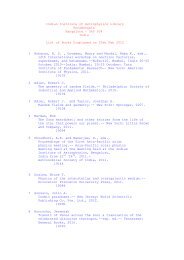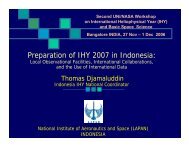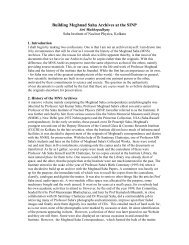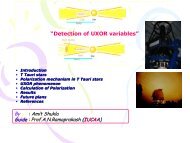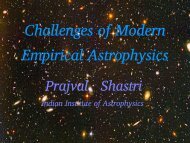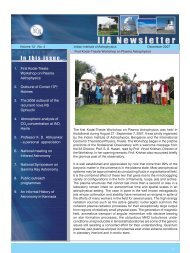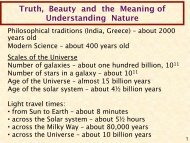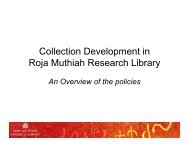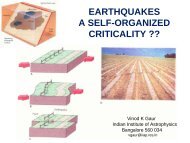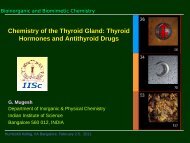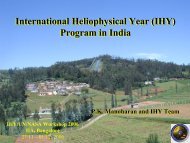Sanjeev Dhurandhar Colloqm - Indian Institute of Astrophysics
Sanjeev Dhurandhar Colloqm - Indian Institute of Astrophysics
Sanjeev Dhurandhar Colloqm - Indian Institute of Astrophysics
Create successful ePaper yourself
Turn your PDF publications into a flip-book with our unique Google optimized e-Paper software.
S. V. DHURANDHAR<br />
IUCAA<br />
PUNE<br />
12 th February 2008 <strong>Indian</strong> <strong>Institute</strong> <strong>of</strong> <strong>Astrophysics</strong> Colloquium
GRAVITATIONAL WAVES<br />
• Space-time warpage in the fabric <strong>of</strong> spacetime<br />
travels with the speed <strong>of</strong> light<br />
Decay in the orbit <strong>of</strong> the<br />
binary pulsar PSR 1913+16<br />
Nobel Prize to<br />
Hulse & Taylor 1993<br />
Gravitational Waves EXIST !<br />
12 th February 2008 <strong>Indian</strong> <strong>Institute</strong> <strong>of</strong> <strong>Astrophysics</strong> Colloquium
GRAVITATIONAL WAVE ASTRONOMY<br />
• Enormous differences between<br />
GW and EM<br />
- Produced by bulk motions <strong>of</strong> matter<br />
- Compact objects:<br />
Blackholes, neutron stars<br />
Binary Inspiral <strong>of</strong> NS, BH<br />
PROBES OF THE UNIVERSE<br />
GW ASTRONOMY !!<br />
12 th February 2008 <strong>Indian</strong> <strong>Institute</strong> <strong>of</strong> <strong>Astrophysics</strong> Colloquium
Effect on a ring <strong>of</strong> test particles<br />
Metric:<br />
∇ 2 − 1 c 2<br />
∂<br />
∂ t 2<br />
h ik = 0<br />
General Wave:<br />
h ik = h t − z/c e ¿<br />
ik h ¿<br />
t − z /c e ik<br />
12 th February 2008 <strong>Indian</strong> <strong>Institute</strong> <strong>of</strong> <strong>Astrophysics</strong> Colloquium
Quadrupole formula :<br />
But h is awfully small !<br />
h ~ 4G c 4<br />
K . E . ns<br />
R<br />
~<br />
<br />
E kin−ns<br />
0 . 1 M c 2 <br />
R<br />
100 Mpc −1 10 −21<br />
Change in arm-length:<br />
L ~ h L<br />
12 th February 2008 <strong>Indian</strong> <strong>Institute</strong> <strong>of</strong> <strong>Astrophysics</strong> Colloquium
Interferometer<br />
Concept<br />
• Laser used to measure<br />
relative lengths <strong>of</strong> two<br />
orthogonal arms<br />
…causing the<br />
interference pattern<br />
to change at the<br />
photodiode<br />
Arms in LIGO are 4km<br />
Measure difference in length to<br />
one part in 10 21 or 10 -18 meters<br />
Suspended<br />
Masses<br />
12 th February 2008 <strong>Indian</strong> <strong>Institute</strong> <strong>of</strong> <strong>Astrophysics</strong> Colloquium
LIGO Louisiana 4 km armlength (US)<br />
12 th February 2008 <strong>Indian</strong> <strong>Institute</strong> <strong>of</strong> <strong>Astrophysics</strong> Colloquium
CURRENT DETECTOR STATUS<br />
• Several large scale laser interferometric detectors<br />
constructed: armlength <strong>of</strong> 300 m to 4 km<br />
- LIGO, VIRGO, GEO, TAMA, AIGO<br />
- LIGO, TAMA, GEO : Already taking data, S5 run <strong>of</strong><br />
LIGO successfully completed: 2005 – 2007 (2 years)<br />
- VIRGO: Engineering runs, Science runs<br />
• Space based detector LISA – 5 million km<br />
- Launch<br />
12 th February 2008 <strong>Indian</strong> <strong>Institute</strong> <strong>of</strong> <strong>Astrophysics</strong> Colloquium
TAMA Japan<br />
300m<br />
Interferometric Detectors<br />
LIGO Louisiana<br />
4000m<br />
Virgo Italy<br />
3000m<br />
AIGO Australia<br />
future<br />
GEO Germany<br />
600m<br />
LIGO Washington<br />
2000m & 4000m<br />
12 th February 2008 <strong>Indian</strong> <strong>Institute</strong> <strong>of</strong> <strong>Astrophysics</strong> Colloquium
International Network <strong>of</strong> GW Interferometers<br />
1. Detection confidence 2. Source direction 3. Polarisation info<br />
LIGO-LHO: 2km, 4km<br />
GEO: 0.6km<br />
VIRGO: 3km<br />
TAMA: 0.3km<br />
LIGO-LLO: 4km<br />
AIGO: ()km<br />
12 th February 2008 <strong>Indian</strong> <strong>Institute</strong> <strong>of</strong> <strong>Astrophysics</strong> Colloquium
Technology pushed to the limits<br />
Vacuum better than 10 -6 torr<br />
1.22 m aperture x 4000 m arms<br />
~9.4 x 10 3 m 3 (each site)<br />
~10 9 Joule <strong>of</strong> stored energy<br />
10 kg test masses<br />
0.99999 @ λ =1.024 µm<br />
5m<br />
10 W @ λ =1.024 µm<br />
~10 20 γ /s to split fringe to 10 -10<br />
Seismic isolation <strong>of</strong><br />
δν/ν~10 -10<br />
ground motion by > 10 -6<br />
12 th February 2008 <strong>Indian</strong> <strong>Institute</strong> <strong>of</strong> <strong>Astrophysics</strong> Colloquium
LIGO beam tube (January 1998 )<br />
12 th February 2008 <strong>Indian</strong> <strong>Institute</strong> <strong>of</strong> <strong>Astrophysics</strong> Colloquium
The noise floor<br />
• Seismic noise at low<br />
frequencies<br />
• Thermal noise at mid<br />
frequencies<br />
• Shot noise at high<br />
frequencies – quantum<br />
nature <strong>of</strong> light<br />
• Technical issues: alignment,<br />
electronics limit us to reach<br />
design sensitivities<br />
12 th February 2008 <strong>Indian</strong> <strong>Institute</strong> <strong>of</strong> <strong>Astrophysics</strong> Colloquium
Experimental noise curves: Initial LIGO from S1 – S5<br />
*http://www.ligocaltech.edu/~lazz/distribution/LSC_Data<br />
12 th February 2008 <strong>Indian</strong> <strong>Institute</strong> <strong>of</strong> <strong>Astrophysics</strong> Colloquium
Astrophysical Sources<br />
• Compact binary inspiral: “chirps”<br />
– NS-NS waveforms are well described<br />
– BH-BH need better waveforms<br />
– search technique: matched templates<br />
• Supernovae / GRBs: “bursts”<br />
– burst signals in coincidence with signals in<br />
electromagnetic radiation<br />
– prompt alarm (~ one hour) with neutrino detectors<br />
• Pulsars in our galaxy: “periodic”<br />
– search for observed neutron stars (frequency, doppler<br />
shift)<br />
– all sky search (computing challenge)<br />
• Cosmological Signals “stochastic background”<br />
12 th February 2008 <strong>Indian</strong> <strong>Institute</strong> <strong>of</strong> <strong>Astrophysics</strong> Colloquium
Source Strengths<br />
Binary inspiral:<br />
h ~ 2.5 × 10 −23 [<br />
M<br />
]5/3<br />
M sun<br />
f a<br />
[<br />
r<br />
] −1[<br />
100 Mpc 100 Hz<br />
]2/3<br />
Periodic:<br />
h ~ 1. 9 × 10 −25 [<br />
I<br />
] 10 45 gm. cm 2<br />
[<br />
f<br />
] 2 [ 500 Hz<br />
r<br />
] −1[<br />
ε<br />
]<br />
10 kpc 10 −5<br />
Stochastic background:<br />
~<br />
h<br />
f ~ 10 −26 [<br />
f<br />
] −3/ 2<br />
10 Hz<br />
[ GW<br />
f <br />
10 −12<br />
]1/ 2<br />
Data Analysis !<br />
12 th February 2008 <strong>Indian</strong> <strong>Institute</strong> <strong>of</strong> <strong>Astrophysics</strong> Colloquium
Inspiraling compact binaries<br />
GW<br />
• Broadband source best for interferometric detectors<br />
• Waveform is well modeled by PN approximations<br />
• Numerical Relativity: great advances - merger<br />
12 th February 2008 <strong>Indian</strong> <strong>Institute</strong> <strong>of</strong> <strong>Astrophysics</strong> Colloquium
Matched filtering the inspiraling binary signal<br />
cτ =∫ x t q t τ dt<br />
~<br />
~<br />
q f = h f <br />
S h<br />
f <br />
12 th February 2008 <strong>Indian</strong> <strong>Institute</strong> <strong>of</strong> <strong>Astrophysics</strong> Colloquium
Parameter space: 1 – 30 solar masses<br />
Sathya & SVD (91)<br />
SVD & Sathya (94)<br />
Owen (96)<br />
LIGO I psd:<br />
Minimal match: 0 .97<br />
f a<br />
= 40 Hz<br />
Number <strong>of</strong> templates: ~ 10 4<br />
Online speed: ~ 3 GFlops<br />
eraFlops for MACHOS, Spins …<br />
12 th February 2008 <strong>Indian</strong> <strong>Institute</strong> <strong>of</strong> <strong>Astrophysics</strong> Colloquium
Event rate, data analysis<br />
• Event rate (from inspiral SNR):<br />
~ 1 event / yr initial LIGO (20 Mpc), 10 events/day for<br />
advanced (350 Mpc)<br />
- Rate computed from survey volume, beaming fraction,<br />
luminosity function, short orbital period etc<br />
• Efficient data analysis techniques (IUCAA):<br />
Hierarchical search Sengupta, <strong>Dhurandhar</strong> & Lazzarini (2003)<br />
Interpolated search Mitra, <strong>Dhurandhar</strong> & Finn (2005)<br />
Coherent network search: Pai, <strong>Dhurandhar</strong> & Bose (2002),<br />
Indo-Japanese: Mukhopadhyay, SVD, Tagoshi, Kanda (2007)<br />
12 th February 2008 <strong>Indian</strong> <strong>Institute</strong> <strong>of</strong> <strong>Astrophysics</strong> Colloquium
Breakthrough in Numerical Relativity<br />
Numerical Relativity<br />
solves<br />
• merger waveform<br />
• 3.5% <strong>of</strong> total<br />
restmass energy as<br />
compared to 1.5 % in<br />
inspiral waveform!<br />
Work in progress on stitching together waveforms<br />
India has the right talent/aptitude for NR<br />
12 th February 2008 <strong>Indian</strong> <strong>Institute</strong> <strong>of</strong> <strong>Astrophysics</strong> Colloquium
Setting upper limits<br />
• Although at this early stage no detection can be announced we<br />
can place upper limits for example on the inspiral event rate<br />
For example for S2 data:<br />
P ρ ρ ¿ = 1 − e −ε R T<br />
R 90 50 y −1 MWEG −1<br />
A rate > than above means there is more than 90% probability<br />
that one inspiral event will be observed with SNR > highest SNR<br />
observed in the data.<br />
Much better event rate from S3, S4, S5 data!<br />
12 th February 2008 <strong>Indian</strong> <strong>Institute</strong> <strong>of</strong> <strong>Astrophysics</strong> Colloquium
Astrophysical Results<br />
• Chirps<br />
– S2: 355 hours <strong>of</strong> coincident (2X, 3X) interferometer operation<br />
– Sensitive to D ~ 2 Mpc<br />
– R 90% < 50 events/year/MWEG (1 Msun < M1,2 < 3 Msun)<br />
• Bursts<br />
– S1: For h > 10 -18 , R90% < 2/day (limited by observation time)<br />
– Minimum h ~ 2 x 10 -19<br />
– S2: 50% detection efficiency h ~ 10 -20<br />
• Periodic, or “CW”<br />
– S2: (LIGO and GEO600) interferometers -- Targeted 28 known pulsars<br />
– h < 1.7 x 10 -24 (J1910-5959D)<br />
– e < 4.5 x 10 -6 (J2124-3358)<br />
– Crab limit on h within 30X <strong>of</strong> spindown rate, if spindown were due to GW emission<br />
• Stochastic background<br />
– S3: 240 hours <strong>of</strong> cross-correlation measurements for H-L, H-H<br />
– Sensitivity estimated to be Ω GW<br />
< 5 x 10 -4 50 Hz < f < 250 Hz<br />
12 th February 2008 <strong>Indian</strong> <strong>Institute</strong> <strong>of</strong> <strong>Astrophysics</strong> Colloquium
The LIGO Scientific Collaboration<br />
500 scientists at 42 institutions<br />
27 US & 15 international<br />
12 th February 2008 <strong>Indian</strong> <strong>Institute</strong> <strong>of</strong> <strong>Astrophysics</strong> Colloquium
Stochastic GW background: Directed search<br />
S.Mitra, SVD, T. Souradeep, A. Lazzarini, V. Mandic, S. Bose, S.<br />
Ballmer (2007) - Ligo Science Collaboration<br />
• Produced by unresolved gravitational wave sources<br />
– Blackhole mergers, r-modes, LMXBs, …<br />
Waveforms not well modelled<br />
• Statistic: : Cross-correlation between two detectors<br />
with a directed optimal filter Q<br />
¿<br />
dt ∬ dt ' dt ``s rSub { size 8{1} } ` \( t' \) `s rSub { size 8{2} } } ` \( t Q <br />
¿<br />
S = ∫¿<br />
¿<br />
; t , t ' − t \) } {}<br />
12 th February 2008 <strong>Indian</strong> <strong>Institute</strong> <strong>of</strong> <strong>Astrophysics</strong> Colloquium
The Kernel or Point Spread Function<br />
LIGO detectors<br />
Point Source on the equator – Image not a point !<br />
12 th February 2008 <strong>Indian</strong> <strong>Institute</strong> <strong>of</strong> <strong>Astrophysics</strong> Colloquium
De-convolving the GW sky-map<br />
The integral equation must be inverted !<br />
D = B .P + n, D = D ( W )<br />
D : data<br />
B : known beam matrix<br />
P : GW power distribution over sky pixels<br />
i<br />
i<br />
n : noise<br />
Solution:<br />
ML estimator:<br />
T - 1 - 1 T -1<br />
P = ( B N B ) B N .D<br />
12 th February 2008 <strong>Indian</strong> <strong>Institute</strong> <strong>of</strong> <strong>Astrophysics</strong> Colloquium
Solution for a broadened point source<br />
Source 4 pixels:<br />
Dirty:<br />
Cleaned:<br />
12 th February 2008 <strong>Indian</strong> <strong>Institute</strong> <strong>of</strong> <strong>Astrophysics</strong> Colloquium
Solution for a `galactic distribution’<br />
Source:<br />
Dirty :<br />
Cleaned:<br />
12 th February 2008 <strong>Indian</strong> <strong>Institute</strong> <strong>of</strong> <strong>Astrophysics</strong> Colloquium
Initial<br />
Advanced<br />
• From Initial LIGO Advanced LIGO<br />
Next Generation LIGO (QND)<br />
• From 14 Mpc (NN inspiral) 200 Mpc and beyond<br />
• From Upper Limits Searches Detections<br />
• From Generic Waveforms Specified Waveforms<br />
• From Single Detectors Global Networks<br />
12 th February 2008 <strong>Indian</strong> <strong>Institute</strong> <strong>of</strong> <strong>Astrophysics</strong> Colloquium
LISA<br />
• A Collaborative ESA / NASA Mission to observe lowfrequency<br />
gravitational waves<br />
• Cluster <strong>of</strong> 3 S/C in heliocentric orbit at 1 AU<br />
• Equilateral triangle with 5 Million km arm-length<br />
• Trailing the earth by 20°<br />
• S/C contain lasers and free-flying test masses<br />
• Equivalent to a Michelson interferometer<br />
12 th February 2008 <strong>Indian</strong> <strong>Institute</strong> <strong>of</strong> <strong>Astrophysics</strong> Colloquium
LISA: Space based detector for detecting low<br />
frequency GW<br />
12 th February 2008 <strong>Indian</strong> <strong>Institute</strong> <strong>of</strong> <strong>Astrophysics</strong> Colloquium
LISA sensitivity curve<br />
• Confusion noise – problem not faced by ground-based detectors<br />
• Low frequency long duration sources<br />
12 th February 2008 <strong>Indian</strong> <strong>Institute</strong> <strong>of</strong> <strong>Astrophysics</strong> Colloquium
Space v/s Terrestrial<br />
12 th February 2008 <strong>Indian</strong> <strong>Institute</strong> <strong>of</strong> <strong>Astrophysics</strong> Colloquium
Fundamental Physics:<br />
LISA SCIENCE<br />
• Tests <strong>of</strong> strong field GR by mergers <strong>of</strong> comparable mass BHs:<br />
- Area theorem – before/after measurements <strong>of</strong> M and J<br />
- Cosmic Censorship – is a/M > 1 after merger<br />
- Stellar mass BH falling into a massive BH – few per year upto<br />
1 Gpc (Sigurdson and Rees, Phinney) - EMRIs<br />
High SNR - Test no-hair theorem ~ detailed waveforms with<br />
10 5 cycles in the last year 10 M falling into 10 6 M BH<br />
• Observe GW bursts from cosmic strings or other exotic sources<br />
12 th February 2008 <strong>Indian</strong> <strong>Institute</strong> <strong>of</strong> <strong>Astrophysics</strong> Colloquium
Αstrophysics:<br />
• Detect BH mergers in the<br />
range 10 5 - 10 7 M<br />
event rate ~ 15/yr<br />
• Study compact WD binaries<br />
- obtain mass spectrum …<br />
LISA SCIENCE contd<br />
• Detect hundreds <strong>of</strong> EMRIs – event rate ~ few hundred/yr<br />
- obtain spectrum <strong>of</strong> masses, spins<br />
• Discover unexpected sources, dark matter components<br />
12 th February 2008 <strong>Indian</strong> <strong>Institute</strong> <strong>of</strong> <strong>Astrophysics</strong> Colloquium
LISA data analysis at IUCAA<br />
Time-delay Interferometry<br />
• Cancellation <strong>of</strong> laser frequency noise and other systematic<br />
noises – optical bench motion, clock jitter, etc,<br />
SVD, Vinet, Nayak, Pai (2002 – 2003)<br />
Polynomial vectors in delay operators:<br />
Module <strong>of</strong> syzygies – space <strong>of</strong> data combinations cancelling<br />
laser frequency noise – Algebraic geometry<br />
• Current Work: General relativistic model needed to account<br />
for all effects<br />
Sagnac effect, changing arm-lengths, gravitational red-shift etc<br />
SVD, Vinet, Chauvineau (2006 - 2008) LISA simulator<br />
12 th February 2008 <strong>Indian</strong> <strong>Institute</strong> <strong>of</strong> <strong>Astrophysics</strong> Colloquium
FUTURE DIRECTIONS<br />
• Global Network <strong>of</strong> detectors LIGO, VIRGO, TAMA, GEO,<br />
AIGO<br />
• Sensitivity upgrades: Amplitude & bandwidth<br />
Advanced detectors: 2008 +<br />
Enhanced systems: lasers, seismic isolation, test-masses<br />
Event rate improvement: ~ 10 4<br />
• LISA will open the low frequency window: 10 -4 Hz – 1 Hz<br />
Many detections! High SNR<br />
Hopefully detections should begin soon with<br />
ground- based detectors<br />
12 th February 2008 <strong>Indian</strong> <strong>Institute</strong> <strong>of</strong> <strong>Astrophysics</strong> Colloquium



